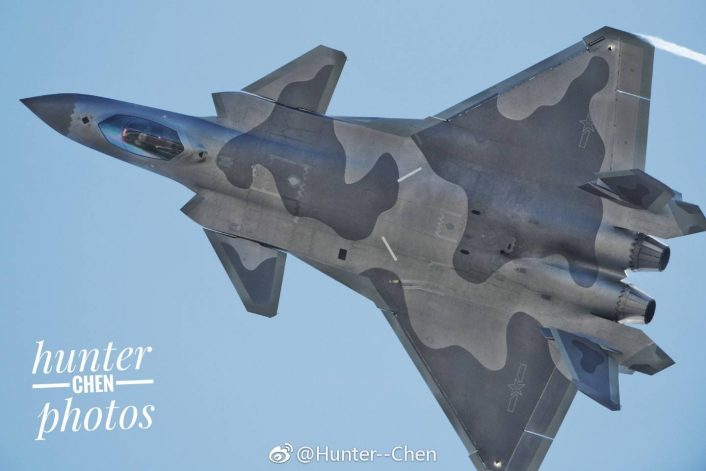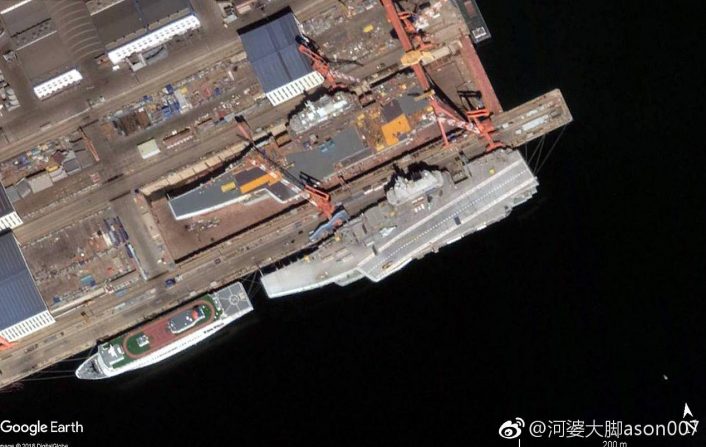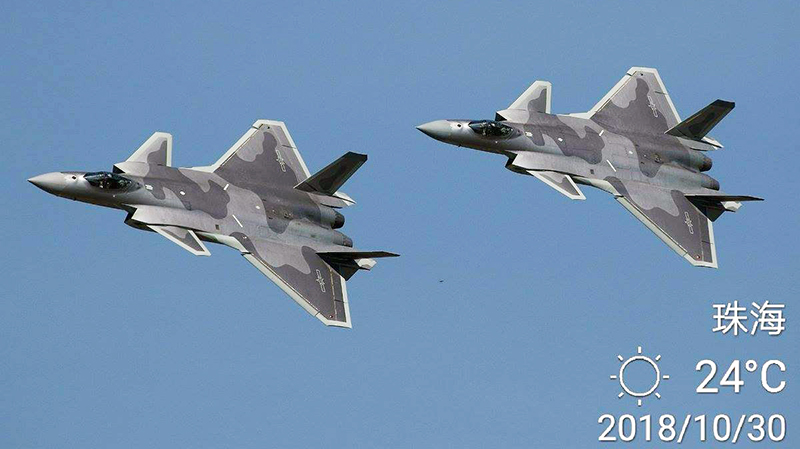Carrier Trials Surge Ahead as China Builds Capability. Zhuhai Airshow Surprises.
China continues to emerge as the most dynamic region for defense program development and introductions among the superpowers. In October, photos of their aircraft carrier development and preparations for ongoing sea trials have surfaced; their advanced interceptor claiming to have low-observable capability has reemerged with a new camouflage scheme in an operational unit; they have flown a new long range flying boat amphibious aircraft and shown a new armed, long range remotely piloted aircraft. There are even frequent reports (some of those have been denied already) of a new low-observable strategic heavy bomber ahead of the U.S. unveiling of their new B-21 Raider long range stealth bomber.
All of this new development continues the conversation about China expanding military ambitions beyond their borders in regions such as Africa, the Middle East and even South and Central America. These ambitions add to their ongoing power projection in the Taiwan Strait and South China Sea.
Perhaps the most significant development is the potential return to a strategic nuclear role for the PLAAF, China’s air force. China’s air delivered nuclear capability has reportedly advanced recently after it was abandoned in the 1980s when China only had air delivered nuclear gravity bombs.
In a September 6, 2018 feature on TheDiplomat.com, analysts Ankit Panda and Prashanth Parameswaran reported that, “The PLAAF once again has a nuclear mission, although we don’t know what that is”. The analysts suggested that an air launched ballistic missile may be an emerging technology China is developing. The missile, thought to be a new version of the CJ-20K long range cruise missile, currently has the capability to strike targets at a range of 1,080 nautical miles (2,000 kilometers) with a conventional warhead after being launched from China’s legacy Xian H-6K heavy bomber.
For the first time ever in early May, 2018, the PLAAF flew Xian H-6K heavy bombers to the disputed Woody Island in the Paracel archipelago. The Paracel archipelago, also called “Xisha” by the Chinese, is a disputed chain of low-lying islands in the South China Sea. Although China has maintained a military presence there since 1974 when they forcibly evicted Vietnam, the Taiwanese and Vietnamese both still lay claim to the islands. A Pentagon statement from U.S. Pacific Command spokesman Lt. Col. Christopher Logan said the May landing of Chinese heavy bombers in the island chain is evidence of “China’s continued militarization of disputed features in the South China Sea.”
The 2018 edition of China International Aviation and Aerospace Exhibition in Zhuhai, Guangdong, will take place in just a few days from November 6-11, 2018. Photographers already at the show venue have shared a feast of interesting images in social media including photos of the Chengdu J-20A “Mighty Dragon” in a completely new operational camouflage scheme.
The Chengdu J-20As seen at the show are claimed “fifth generation” twin engine, single seat air superiority fighters with a distinctive canard, delta wing and twin tail configuration. They are reported to be operated by the172th Brigade based at the FTTB (Airbase) at Cangzhou according to expert analyst Andreas Rupprecht who maintains the Modern Chinese Warplanes page on Facebook and publishes a series of authoritative reference guides about Chinese military aircraft (and many others) through Harpia Publishing.

Rupprecht noted that two of the J-20A aircraft wore serial numbers 78231 and 78232. He also pointed out that the aircraft previously had an angular “splinter” style camouflage scheme but now have a new, rounded pattern camouflage livery.
In conjunction with the timing of the Zhuhai Airshow, Rupprecht’s Harpia Publishing has just released their latest reference book, “Modern Chinese Warplanes: Chinese Air Force – Aircraft and Units”.
Other unique aircraft photographed arriving at Zhuhai for the 2018 China International Aviation and Aerospace Exhibition include a unique J-10B prototype aircraft number ‘1034’ modified to with a special thrust vectoring engine nozzle. The modification is likely a test version according the Andreas Rupprecht that has been retrofitted onto the existing WS-10 jet engine.

China’s naval aviation program also arcs forward into a rapidly developing and ambitious future with their aircraft carriers. On October 28, 2018, the new, unnamed Type 002 aircraft carrier sailed away from its construction and maintenance facility at Dalian, China for its third sea trial. Andreas Rupprecht observed on his Modern Chinese Warplanes page on Facebook (Author’s note: this page is worth “Liking”) that the ship’s flight deck had been cleaned and possibly prepared for flight deck trials during this current shakedown cruise.
Of equal interest is a photo that surfaced on Google Earth that is only a few weeks old, taken on September 22, 2018, showing the two Chinese aircraft carriers sitting side-by-side in their maintenance and construction yard in Dalian. Dalian is a modern, rapidly growing port city on the Liaodong Peninsula, at the southern tip of China’s Liaoning Province.

Video of the new AVIC AG600 Kunlong flying boat making its first ever waterborne take-off and landing were posted to YouTube on October 20, 2018. The impressive four-engine turboprop aircraft is intended for the long range maritime patrol, reconnaissance, search and rescue mission. It is said to be capable of operating in sea state 3 conditions, or waves as high as 6.6-feet (2 meters). With its projected range of 2,796 miles (4,500 km), the AG600 flying boat can reach the contested islands in the outlying regions of China’s sea.
In addition to global power projection in their own interests, an aim of China’s emerging new military aviation push is the export market. In early October 2018, the sale of 48 new Wing Loong II armed, remotely piloted aircraft to Pakistan was announced.
According to analyst Shaurya Karanbir Gurung of India’s Economic Times in a story published on October 10, 2018, “The Wing Loong II is an improved version of the Wing Loong 1 Unmanned Aerial Vehicle. Falling in the category of Medium Altitude Long Endurance, it is manufactured by the Chengdu Aircraft Industrial (Group) Company. The UAV has been developed primarily for People’s Liberation Army Air Force and export. The concept of the Wing Loong II was unveiled at the Aviation Expo China in Beijing in September 2015.”
And finally, and perhaps most interestingly, news about an entirely new, long range low observable Chinese heavy bomber has surfaced. According to some reports, the program is claimed to be significantly advanced in its development. The Hong-20 is tipped as China’s new long-range strategic stealth bomber. Official Chinese media has released concept images of the aircraft after teasing shapes earlier in the year in what appeared to be a direct parody of a video touting the upcoming U.S. bomber, the B-21 Raider.

Defense World.net reported that, “The Hong-20 official unveiling could be slated for next month’s Zhuhai Air show though there is no confirmation of it as yet.” The report went on to reveal that Russian media outlet Rossiyskaya Gazeta claimed the Hong-20 bomber has been under development at the Shanghai Aircraft Design and Research Institute in China since 2008.

Many casual observers of China’s defense and aviation programs have been cynical of China’s ability to produce truly advanced high-end, reliable new military technologies that may compete with western technology. Because of lingering dogma about China’s mass manufacturing being comprised largely of knock-offs from western technology mimicked quickly at lower cost and lower quality by legions of near-slave laborers, this mistaken stereotype has lingered. Anyone who has visited China recently knows this country has vaulted into a new era of economic, technological and now, military development. Given that China is the country that invented gunpowder and revolutionized warfare, any country that underestimates China’s new capabilities does so at their own peril.
Top image: Two of the J-20A Mighty Dragons arrived ahead of the Zhuhai Airshow with brand new paint schemes. (Photo: via Modern Chinese Warplanes on Facebook)









